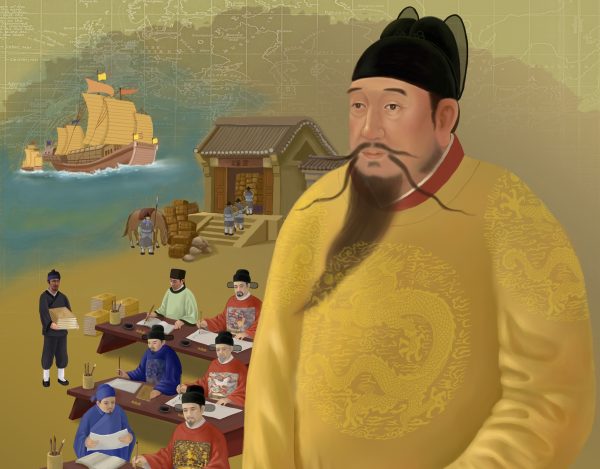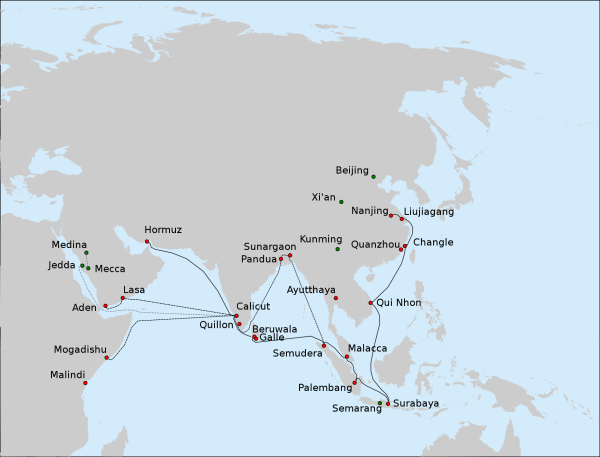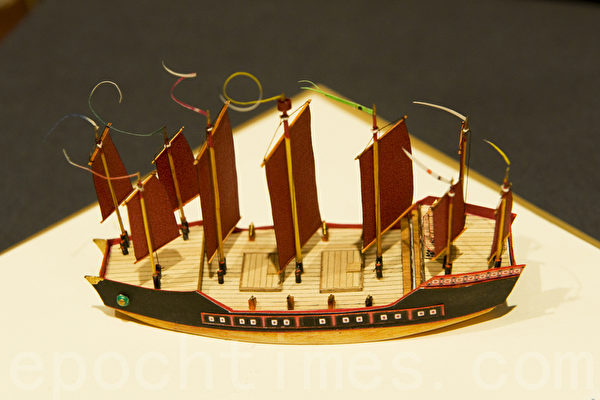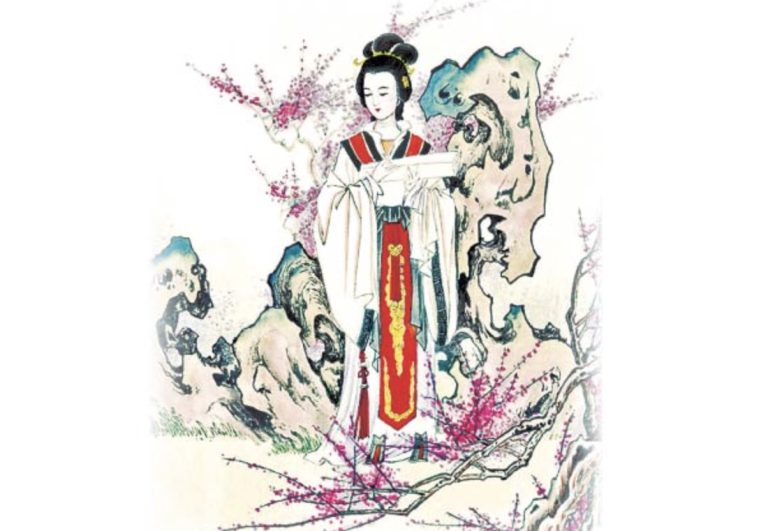Ask an American to name the world’s greatest maritime explorers and you will likely hear the names of Christopher Columbus, Vasco da Gama, Leif Erickson, Ferdinand Magellan, or Francis Drake. But few would name the sailor who led a fleet of the largest ships the world had ever seen, almost a full century before Christopher Columbus. His name was Zheng He, and for 18 years, he commanded Chinese “treasure ships” across the Indian Ocean to India, the Malay Peninsula, the Persian Gulf, and the east coast of Africa. When he died, the fleet died with him, but his accomplishments live on.
His story starts in 1371 with the birth of Ma He in what was then the Mongol Empire. When he was about 10 years old, the Chinese rebel army captured Yunnan, the province where Ma He lived; he was taken prisoner. As was customary, he was castrated and enslaved. He became a eunuch in the service of Zhu Di, the fourth son of the Chinese Ming emperor. Surprisingly, the two became close colleagues, as Ma accompanied the prince on his military campaigns.
Ma He was said to be 7 feet tall with a waist that measured 60 inches around — a formidable presence indeed. When the emperor died, Zhu Di battled his way to the throne, declaring himself the Yongle emperor in 1402. He gave Ma a new surname, Zheng, which was the name of Zhu Di’s favorite horse.

Yongle was active and ambitious. He moved the Chinese capital from Nanjing to Beijing. He conquered, then lost, what is now Vietnam. Unusually, Yongle gave several government jobs to eunuchs; Zheng He, a member of China’s Muslim minority population, became what we might call the chief of staff.
Yongle seemed determined to exact tribute from neighboring countries. He ordered the construction of a great navy under the supervision of Zheng He. These were the largest ships the world had ever known. Zheng He’s flagship was more than 400 feet from bow to stern and 210 feet wide. There were four decks and nine masts rigged with square sails. In contrast, Columbus’s three-masted Santa Maria was just 117 feet long. Columbus’s other ships, Nina and Pinta were even smaller. In 1962 a massive rudder of appropriate date was found, confirming the enormous size of the Chinese ships.
Success
You are now signed up for our newsletter
Success
Check your email to complete sign up
In 1405, Zheng He led a convoy of 62 such ships followed by about 200 smaller ships all protected by 28,000 armed men, across the Indian Ocean to Calicut, now Kozhikode, Kerala, India. Although some trading surely took place, this was not a mercantile expedition. China had already been trading with Calicut for centuries. Nor was it a voyage of pure exploration: the Chinese already knew all the ports and countries of the Indian Ocean.

Rather, Zheng He and his fleet were there to demonstrate that Chinese power had not been diminished by the battles of succession, and to confirm the tributary status of Calicut. Although Zheng He’s large crafts were called treasure ships, the treasure they carried came from China and was there to impress the rulers of the ports they visited with the wealth and therefore power of China. Zheng He merely collected exotic gifts and toys for his emperor. The appropriate response for the foreign ruler was awe and the offering of tribute. On his way home Zheng He conquered a fleet of pirates, killing 5,000 of them. He would later boast that he had made the sea free for trade.
The contrast with European exploration is again remarkable. Ninety years later, Vasco da Gama, sent by the King of Portugal, also arrived at Calicut, but he came for conquest and trade. And he came with just three ships each about 89 feet long. Vasco da Gama could not have been more unlike the powerful and successful diplomat Zheng He. Da Gama must have seemed an errant ruffian. He managed to quarrel with the ruler of Calicut and left without any permanent trade arrangements.
Between 1408 and 1411 Zheng He made two more voyages across the Indian Ocean. But it was in 1413 that Yongle ordered the most impressive maritime expedition of all. Zheng He took 63 of these immense treasure ships and other smaller craft together with more than 27,000 men across the Indian Ocean. He visited the Malay Peninsula and Sri Lanka before reaching Calicut. From there he sailed to the Maldive and Laccadive Islands, then on to Hormuz, an Arab port on the Persian Gulf.
At all these ports Zheng He left silk and spices, and took on board envoys or representatives to carry back to the Chinese court. In 1417, the Yongle Emperor ordered Zheng He to return the envoys home. Zheng He and a large fleet set sail for his fifth expedition visiting many of the same places. On this trip, Zheng He went further: he sailed down the East African coast as far south as what is now Kenya.
Zheng He went back to sea again in 1421, and by the time he got back to China in 1422, the Yongle emperor had died. His son, the Hongxi Emperor, not interested in maritime adventures, reassigned Zheng He to supervise the construction of a large temple in Beijing.
Nine years later, in 1430, after the Hongxi Emperor had died and his son became the Xuande Emperor, Zheng He set sail on his last voyage as commander of the great Chinese fleet. Before leaving Chinese waters, Zheng He constructed two granite monuments on which he had inscribed reports of his voyages: “[We have] traversed over a hundred thousand li of vast ocean [and have] beheld great ocean waves, rising as high as the sky and swelling and swelling endlessly. Whether in dense fog and drizzling rain or in wind-driven waves rising like mountains, no matter what the sudden changes in sea conditions, we spread our cloudlike sails aloft and sailed by the stars day and night.” What adventurous and dangerous travels!
They sailed on around the Indian Ocean visiting Sumatra and Java before reaching Calicut.
Zheng He took time out to make the hajj to Mecca. This was his second pilgrimage: decades earlier he and his father had traveled to Mecca from Mongolia. Returning to the fleet, Zheng He became ill. He died in 1433: it is not clear if he died at sea or survived long enough to get back home to China.

And that was the end of the immense Chinese treasure fleet. The Chinese Emperor ordered them to remain in the harbor, and those huge ships were either left to rot or were burnt at their moorings. But why?
There seems to have been three reasons. Firstly, the money. These expeditions had been very costly: they had not been trading expeditions bringing home profitable merchandise. As a result the treasury was low.
Secondly, there were recurrent threats to the Chinese Empire’s land borders. The Mongols and other groups were attacking the Chinese in the west. Resources had to be transferred there to maintain the empire’s integrity.
Thirdly, the emperors had become more attentive to an ancient version of political correctness. According to the teachings of neo-Confucianism, trade was a suitable vocation only for those of the lowest social order, if not actually immoral. Merchants were considered parasites on those who actually produced the goods to be traded. Sending out fleets was not appropriate policy for the august Chinese Emperor.
This history of the Chinese treasure fleet must prompt thoughts of what might have been. Zheng He’s fleet was easily strong enough to keep the Indian Ocean clear of European explorers and traders in their tiny boats. Imagine a new world history without an eastern Dutch empire, without a British East India Company! And what if Zheng He had guided his fleet to the east, across the Pacific? Had he done so, he might have discovered the Americas almost a century before Columbus got there.













